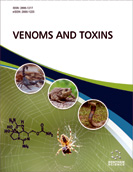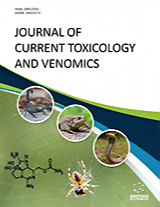Abstract
Phospholipases A2 enzymes are found in many mammalian tissues and in animal venoms. Those present in bee venom (bvPLA2) and snake venom (svPLA2) have been studied more particularly for their biological activities of interest. Although they belong to the same family of secreted PLA2 (sPLA2), bvPLA2 and svPLA2 differ from a structural and functional point of view. In this review, we describe the morphological characteristics of these two enzymes and the structural determinants that govern their functions. After describing their cytotoxicity, we compared their biological activities, including antimicrobial, anti-tumor, anti-inflammatory, anti-neurodegenerative, and anti-nociceptive effects. In addition, we highlighted their therapeutical applications and deduced that bvPLA2 has better potential than svPLA2 in biotechnological and pharmaceutical innovations.
Keywords: phospholipase A2, bee venom, snake venom, bvPLA2, svPLA2, toxicity, therapeutical applications.
[http://dx.doi.org/10.1016/j.toxicon.2019.09.019] [PMID: 31563525]
[http://dx.doi.org/10.1039/C7CP06344J] [PMID: 29149234]
[http://dx.doi.org/10.1016/j.bbalip.2006.07.011] [PMID: 16973413]
[http://dx.doi.org/10.1016/S1388-1981(00)00105-0] [PMID: 11080672]
[http://dx.doi.org/10.1021/cr200085w] [PMID: 21910409]
[http://dx.doi.org/10.1128/JB.00623-18] [PMID: 30455285]
[http://dx.doi.org/10.1093/emboj/20.18.5079] [PMID: 11566873]
[http://dx.doi.org/10.1016/j.phytochem.2016.07.010] [PMID: 27473012]
[http://dx.doi.org/10.1016/1357-2725(95)00083-2] [PMID: 7496992]
[http://dx.doi.org/10.1080/10826076.2014.968660]
[http://dx.doi.org/10.1016/j.gene.2007.03.007] [PMID: 17466468]
[http://dx.doi.org/10.3390/toxins11040191] [PMID: 30935025]
[http://dx.doi.org/10.1016/j.biochi.2014.09.003]
[PMID: 2925608]
[http://dx.doi.org/10.1007/s10557-008-6134-7] [PMID: 18853244]
[http://dx.doi.org/10.1016/S0006-3495(01)76058-4] [PMID: 11159446]
[http://dx.doi.org/10.3390/molecules24162997] [PMID: 31430861]
[http://dx.doi.org/10.3390/molecules23102721] [PMID: 30360399]
[http://dx.doi.org/10.2174/1871526514666140522114754] [PMID: 24853875]
[http://dx.doi.org/10.1016/0926-6542(64)90101-5] [PMID: 14124757]
[http://dx.doi.org/10.1016/0041-0101(96)00036-0] [PMID: 8875770]
[http://dx.doi.org/10.1126/science.2274788] [PMID: 2274788]
[http://dx.doi.org/10.1016/j.toxicon.2016.11.251] [PMID: 27867095]
[http://dx.doi.org/10.1016/j.toxicon.2016.02.021] [PMID: 26927324]
[http://dx.doi.org/10.1111/j.1432-1033.1974.tb03787.x] [PMID: 4448181]
[http://dx.doi.org/10.1016/j.biochi.2010.09.012] [PMID: 20884319]
[http://dx.doi.org/10.3390/toxins9120406] [PMID: 29311537]
[http://dx.doi.org/10.1073/pnas.90.1.342] [PMID: 8419939]
[http://dx.doi.org/10.1074/jbc.270.5.2120] [PMID: 7836440]
[http://dx.doi.org/10.1159/000500957] [PMID: 31216540]
[http://dx.doi.org/10.1126/science.2704992] [PMID: 2704992]
[http://dx.doi.org/10.1016/0091-6749(76)90076-2] [PMID: 54382]
[http://dx.doi.org/10.1038/ni.2586] [PMID: 23624557]
[PMID: 7544378]
[http://dx.doi.org/10.1111/j.1365-2249.2007.03542.x] [PMID: 18005261]
[http://dx.doi.org/10.1016/j.immuni.2013.10.006] [PMID: 24210353]
[http://dx.doi.org/10.1084/jem.20141505] [PMID: 25584012]
[http://dx.doi.org/10.1016/S0041-0101(99)00143-9] [PMID: 10665801]
[http://dx.doi.org/10.1016/j.expneurol.2007.06.010] [PMID: 17678647]
[http://dx.doi.org/10.1002/ana.20798] [PMID: 16498630]
[http://dx.doi.org/10.1016/0742-8413(90)90191-B] [PMID: 1981342]
[http://dx.doi.org/10.1007/s10555-011-9339-3] [PMID: 22109081]
[http://dx.doi.org/10.1016/j.toxicon.2014.07.010] [PMID: 25088177]
[PMID: 27826409]
[http://dx.doi.org/10.1016/j.toxlet.2016.06.005]
[http://dx.doi.org/10.1097/00005072-199612000-00006] [PMID: 8957446]
[http://dx.doi.org/10.1016/j.expneurol.2009.07.017] [PMID: 19631643]
[http://dx.doi.org/10.1016/j.toxicon.2007.11.001] [PMID: 18083205]
[http://dx.doi.org/10.1016/j.toxicon.2010.01.011] [PMID: 20109480]
[http://dx.doi.org/10.1016/j.toxicon.2003.11.006] [PMID: 15019493]
[http://dx.doi.org/10.1016/j.toxrep.2018.02.011] [PMID: 29854600]
[http://dx.doi.org/10.1186/s40409-018-0170-y] [PMID: 30498509]
[http://dx.doi.org/10.1016/j.toxicon.2016.03.006] [PMID: 26975252]
[http://dx.doi.org/10.1073/pnas.1009128107] [PMID: 20660736]
[http://dx.doi.org/10.1111/j.1365-2672.2006.03161.x] [PMID: 17309613]
[http://dx.doi.org/10.3390/molecules25102402] [PMID: 32455792]
[http://dx.doi.org/10.1590/0001-3765201520130511] [PMID: 25806982]
[http://dx.doi.org/10.3831/KPI.2016.19.023] [PMID: 27695631]
[http://dx.doi.org/10.1074/jbc.M109699200] [PMID: 11694541]
[http://dx.doi.org/10.1016/j.exppara.2008.02.002] [PMID: 18343372]
[http://dx.doi.org/10.3390/toxins5020203] [PMID: 23348053]
[http://dx.doi.org/10.1021/bi9528412] [PMID: 8605210]
[http://dx.doi.org/10.1172/JCI6915] [PMID: 10487775]
[http://dx.doi.org/10.1124/mol.60.2.341] [PMID: 11455021]
[http://dx.doi.org/10.3390/toxins5101780] [PMID: 24131891]
[http://dx.doi.org/10.1007/s10989-017-9641-1] [PMID: 30416405]
[http://dx.doi.org/10.1142/S0192415X19500952] [PMID: 31786944]
[http://dx.doi.org/10.1021/bm8013022] [PMID: 19354276]
[http://dx.doi.org/10.1016/j.pharmthera.2007.04.004] [PMID: 17555825]
[http://dx.doi.org/10.1007/s00262-006-0220-0] [PMID: 16947021]
[http://dx.doi.org/10.1007/s00018-002-8465-z] [PMID: 12088277]
[http://dx.doi.org/10.1016/j.etp.2017.01.001] [PMID: 28077256]
[http://dx.doi.org/10.1016/j.toxicon.2006.01.010] [PMID: 16542694]
[http://dx.doi.org/10.1111/j.1745-7254.2007.00530.x] [PMID: 17376294]
[http://dx.doi.org/10.1038/aps.2011.116] [PMID: 21946324]
[http://dx.doi.org/10.1002/jcb.22404] [PMID: 19937732]
[http://dx.doi.org/10.1016/j.biochi.2006.10.010] [PMID: 17110015]
[http://dx.doi.org/10.1271/bbb.100783] [PMID: 21597201]
[http://dx.doi.org/10.1016/j.matbio.2009.03.007] [PMID: 19351557]
[http://dx.doi.org/10.1371/journal.pone.0010124] [PMID: 20405031]
[http://dx.doi.org/10.1016/j.coi.2015.09.002] [PMID: 26432763]
[http://dx.doi.org/10.3390/toxins8050131] [PMID: 27144583]
[http://dx.doi.org/10.4049/jimmunol.1500386] [PMID: 26453752]
[http://dx.doi.org/10.1002/iid3.76] [PMID: 26734460]
[http://dx.doi.org/10.1038/ki.2015.147] [PMID: 25993317]
[http://dx.doi.org/10.1111/all.12691] [PMID: 26179427]
[http://dx.doi.org/10.1111/j.1365-2222.2007.02887.x] [PMID: 18070166]
[http://dx.doi.org/10.3390/toxins10040146] [PMID: 29614845]
[http://dx.doi.org/10.1038/s41598-017-04498-8] [PMID: 28642580]
[http://dx.doi.org/10.1042/BJ20070844] [PMID: 17868035]
[http://dx.doi.org/10.3892/ijmm.2011.730] [PMID: 21701769]
[http://dx.doi.org/10.1124/jpet.102.041616] [PMID: 12805474]
[http://dx.doi.org/10.1186/s12974-016-0476-z] [PMID: 26772975]
[http://dx.doi.org/10.1038/s41598-018-35030-1] [PMID: 30478329]
[http://dx.doi.org/10.3390/toxins7072422] [PMID: 26131771]
[http://dx.doi.org/10.1016/j.pbb.2008.08.016] [PMID: 18778727]
[PMID: 23577231]
 22
22 1
1




